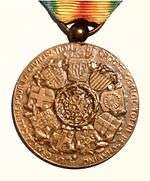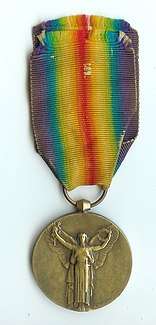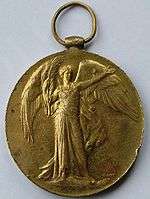Victory Medal (Romania)
The Victory Medal is a Romanian First World War campaign medal established on 20 July 1921 by Royal Decree.[1]
| Victory Medal | |
|---|---|
.jpg) Obverse (left) and reverse (right) of the medal | |
| Awarded by Romania | |
| Type | Campaign medal |
| Eligibility | Romanian Army |
| Awarded for | Campaign service |
| Campaign(s) | First World War, Hungarian–Romanian War |
| Description | Bronze disk, 36mm diameter |
| Clasps | None |
| Statistics | |
| Established | 20 July 1921 |
| Total awarded | around 300.000 |
| Precedence | |
| Next (higher) | Commemorative Cross of the 1916–1918 War |
Ribbon bar | |

The design and ribbon was also adopted by Belgium, Brazil, Cuba, Czechoslovakia, France, Greece, Italy, Japan, Portugal, Romania, Siam, Union of South Africa and the US in accordance with the decision of the Inter-Allied Peace Conference at Versailles (a Winged Victory). A particular form of the historic Greek monument of 'Victoria' was chosen by each nation, except the nations in the Far East who issued the medal but with a different design.
Eligibility
To qualify for the Victory Medal, recipients, of any rank, had to be mobilised for war service and to have taken part in a battle between 28 August 1916 and 31 March 1921, or to have served as an army medic. Thus were also included the combatants from the Hungarian–Romanian War.[1][2]
Description
The design proposals of the medal were to be submitted to an international jury. For the Romanian version, the jury selected the design of Lt. Col. Constantin Kristescu, who was also put in charge with its effective sculpting.[3] It was manufactured in Paris,[4] where Kristescu used to work with La Maison Arthus-Bertrand.[5] The Victory Medal issued by Romania is a 36mm diameter circular bronze medal.
- The obverse of the Romanian version shows the winged, full-length, full-front, standing figure of 'Victory', holding a palm branch in her left hand and a sword pointing downward in her right hand.
- The reverse has the words "MARELE RĂZBOI / PENTRU / CIVILIZAȚIE" ("The Great War / For / Civilization") in three lines, over a halberd, all surrounded by a ring with twenty links braided with a laurel and oak wreath. On each of the ten large links is engraved the name of one of the Allied countries: England, Belgium, Greece, Japan, Serbia, United States, China, Romania, Italy and France. The sculptor signed himself as 'Kristesko' near Japan's link.
- The 39mm wide ribbon has an iridescent colour scheme, with the violet moving through to a central red stripe where both schemes meet.
Usage and hierarchy
The medal was displayed on official occasions and ceremonies on the left breast of the jacket. On other occasions, it was customary to display only the ribbon bar, pinned on the left buttonhole. In the hierarchy of the Romanian military and civil awards and decorations from the mid 1930s, the Victory Medal held the very low 33rd place. The customary hierarchy of the military decorations was (not including those from the Independence War):[6]
- Order of Michael the Brave
- The Military Virtue
- The Aeronautical Virtue
- The Cross of Queen Marie
- The Sanitary Merit Cross
- Valour and Faith with swords
- The Country's Momentum
- Commemorative Cross of the 1916–1918 War
- Victory Medal
International award
As well as Romania, a significant number of allied and associated countries involved in the conflict against the Austro-German alliance issued a Victory Medal.
The proposition of such common award was first made by French marshal Ferdinand Foch who was supreme commander of the allied force during the war. Each medal in bronze has the same diameter (36 mm) and ribbon (double rainbow) but with a national design representing a winged victory except for Japan and Siam where the concept of a winged victory was not culturally relevant.
| Country | Designer | Manufacturer | Number issued | Obverse | Reverse | Established by |
|---|---|---|---|---|---|---|
| Belgium | Paul Du Bois (1859-1938) | ----- | 300,000 - 350,000 |  |
 |
Royal Decree from 15 July 1919 |
| Brazil | Jorge Soubre (1890-1934) | approximately 2,500 | .jpg) |
.jpg) |
Decree nr. 16074 from 22 June 1923 | |
| Cuba | Charles Charles |
|
6,000 - 7,000 | .jpg) |
.jpg) |
Decree nr. 905 from 10 June 1922 |
| Czechoslovakia | Otakar Španiel (1881-1955) |
|
approximately 89,500 | .jpg) |
.jpg) |
Decree from 27 July 1920 |
| France | Pierre-Alexandre Morlon (1878 - 1951) | approximately 2,000,000 |  |
 |
Law from 20 July 1922 | |
| France[8] | Charles Charles |
|
----- | Law from 20 July 1922 | ||
| France[8] |
|
----- | ----- | Law from 20 July 1922 | ||
| United Kingdom[9] | William McMillan (1887–1977) |
|
6,334,522 plus |  |
 |
Decree from 1 September 1919 |
| Greece | Henry-Eugène Nocq (1868-1944) |
|
approximately 200,000 |  |
 |
Law from 22 September 1920 |
| Italy | Gaetano Orsolini (1884-1954) |
|
approximately 2,000,000 |  |
 |
Royal Decree nr. 1918 from 16 December 1920 |
| Japan[10] | Shoukichi Hata | approximately 700,000 | .jpg) |
_crop.jpg) |
Imperial Edict nr 406 from 17 September 1920 | |
| Poland[11] | .... Vlaitov |
|
----- |  |
 |
|
| Portugal | João Da Silva (1880-1960) |
|
approximately 100,000 |  |
 |
Decree from 15 July 1919 |
| Romania | Constantin Kristescu (1871-1928) |
|
approximately 300,000 |  |
.jpg) |
Royal Decree nr 3390 from 20 July 1921 |
| Siam (Thailand) | Itthithepsan Kritakara (1890-1935) | ----- | approximately 1,500 | .jpg) |
.jpg) |
|
| South Africa[12] | William McMillan (1887–1977) |
|
approximately 75,000 |  |
Decree from 1 September 1919 | |
| United States | James Earle Fraser (1876-1953) |
|
approximately 2,500,000 | %2C_Obverse.jpg) |
%2C_Reverse.jpg) |
General Order nr 48 from 9 April 1919 of the Department of War |
References
- Royal Decree nr. 3390 from 20 July 1921, published in "Monitorul Oficial" nr. 121 from 2 September 1921.
- Constantin Flondor, Constantin Moisil, Decorațiunile românești [Romanian decorations], in "Enciclopedia României", vol. I, Bucharest, 1938, p. 93.
- I.G. Probota, Medalistica noastră în 1921 [Our medals in 1921], in "Buletinul Societății Numismatice Române", nr. 40 from October–December 1921, Bucharest, p. 127.
- Constantin Moisil, Medalistul C. Kristescu [The medalist C. Kristescu], in "Cronica Numismatică şi Arheologică", Bucharest, VIII, nr. 83-88, 1928, p. 26.
- Katiușa Pârvan, Angela Mihalea, Câteva date privind opera medalistică a sculptorului Constantin Kristescu [Information regarding the medals created by sculptor Constantin Kristescu], in "Acta Moldaviae Meridionalis", XV-XX. vol. 2, pp. 294-295.
- Constantin Flondor, Constantin Moisil, Decorațiunile românești [Romanian decorations], in "Enciclopedia României", vol. I, Bucharest, 1938, pp. 96-97.
- The interallied victory medals of World War I by Alexander J. Laslo, Dorado Publishing, Albuquerque. 1986 Edition.
- Unofficial type.
- Awarded not only to British combatants but as well to those from the dominions of Canada, Australia, New Zealand and those from the Empire of India.
- On the obverse the winged figure of Victory was replaced by Takemikazuchi, the war god in Japanese mythology.
- For reasons still not known, Poland did not proceed with the manufacture of the medal at their mint. The medal shows a clearly visible “MK” (Mint Kremnica). The medal may possibly be an unofficial strike by a veterans’ group.
- The text on the reverse is in English and Dutch.
External links
- Romanian Victory Medal at "Romanian Medals & Orders".